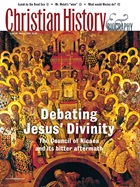"Now because it was agreed formerly that the Synod of Bishops should meet at Ancyra of Galatia, it hath seemed to us on many accounts that it would be well for a Synod to assemble at Nicaea, a city of Bithynia, both because the Bishops from Italy and the rest of the countries of Europe are coming, and because of the excellent temperature of the air, and in order that I may be present as a spectator and participator in those things which will be done. Wherefore I signify to you, my beloved brethren, that all of you promptly assemble at the said city, that is at Nicaea."
—Constantine
303 The "Great Persecution" begins under Emperor Diocletian.
313 The Edict of Milan extends religious freedom to all, including Christians.
c. 318 A theological dispute between Bishop Alexander of Alexandria and one of his presbyters, Arius, sparks a storm of correspondence and public controversy.
324 Constantine defeats Licinius and becomes the sole ruler of the Roman Empire. He sends a letter to Alexander and Arius pleading with them to set aside their differences.
325 The Council of Antioch supports Alexander's views against Arius, deposes Eusebius of Caesarea, and plans a general council to be held in Ancrya (moved to Nicaea by Constantine).
325 The Council of Nicaea produces a creed affirming that Christ is of the same substance as the Father and condemns the teaching of Arius. Eusebius of Caesarea is reinstated. Arius and his supporters are exiled.
328 Athanasius succeeds Alexander as bishop of Alexandria.
337 Constantine's son Constantius embraces Arianism. The Nicene Creed is nearly eclipsed amidst a dizzying array of councils and creeds for several decades.
c. 340 The Arian missionary Ulphilas evangelizes the Goths.
350-3 After a civil war, Constantius II becomes sole ruler of the Empire.
350s Tensions build between heterousian and homoiousian theologians.
359 and 360 Constantius calls two councils that promulgate a homoian creed.
360-380 Pro-Nicene theologians rally around the Nicene Creed as an orthodox alternative to Arian creeds.
381 The Council of Constantinople, summoned by Emperor Theodosius, reaffirms and expands the Nicene Creed.
451 The Council of Chalcedon proclaims the two natures of Christ. After this, the church looks to the Council of Nicaea as the beginning point for establishing orthodoxy.
Canonical Conundrum
The Council of Nicaea's attempt to appeal to Scripture ended up revealing the fundamental difference between Alexander and Arius: how are Christians to understand the biblical statements about Christ? Alexander and Athanasius appealed to scriptural texts that spoke of the Son's generation from the Father or that declared the unity of Father and Son:
- "He is the image of the invisible God, the firstborn over all creation." (Col. 1:15)
- "I and the Father are one." (John 10:30)
- "The Son is the radiance of God's glory and the exact representation of his being, sustaining all things by his powerful word. After he had provided purification for sins, he sat down at the right hand of the Majesty in heaven. So he became as much superior to the angels as the name he has inherited is superior to theirs." (from Hebrews 1:1-6)
Arius drew upon Scripture passages that spoke of the Son being distinct from the Father, particularly texts that spoke of profound differences between the two:
- "The Lord brought me forth as the first of his works, before his deeds of old." (Prov. 8:22)
- " … for the Father is greater than I." (John 14:28)
- "Now to the King eternal, immortal, invisible, the only God, be honor and glory for ever and ever. Amen." (1 Tim 1:17)
According to Athanasius, the council's endeavor to settle upon the right terminology to describe Jesus' relationship to God the Father began with the many different scriptural titles for Christ. How were they all to be read? Word, Power, Wisdom, Angel of the Lord, Servant, Morningstar, Son of David, and Son of Man are some of the important Old Testament titles given to the Son. Son, Word, Lord, Power, Light, Shepherd, Stamp of God's substance, Life, Rock, and Door are some of the important New Testament titles given to the Son. Were all of these titles given in the same way or in the same sense? Was Jesus the "Word" in the same way he was the "Door"? Furthermore, were these titles given in a unique way to Jesus? Was Jesus called the "Son of God" as the Israelites were called sons of God and those who believed in Jesus were now the sons and daughters of God? Was God Jesus' "father" in just the same way he was "our father"?
—Michel Rene Barnes
Doctrinal Dysfunction
Modalists (or Sabellians): God's names (Father, Son, Holy Spirit) change with his role or "modes of being" (like a chameleon). When God is the Son, he is not the Father. There is no permanent distinction between the three "persons" of the Trinity, otherwise you have three gods.
Eusebians: There is a closeness between the Father and Son, but they are distinct beings (see p. 40).
Homoians: The Son is like the Father, but he is a distinct and inferior being.
Heterousians (or Eunomians): The Father and the Son are unlike in essence.
Homoiousians: The Son is like the Father in essence; he differs from the Father only in not being unbegotten.
Nicene orthodoxy: The Father and Son are of the same essence, but they are not different "parts" of God. God is indivisibly One yet Three.
Copyright © 2005 by the author or Christianity Today/Christian History & Biography magazine.
Click here for reprint information on Christian History & Biography.

Support Our Work
Subscribe to CT for less than $4.25/month




























